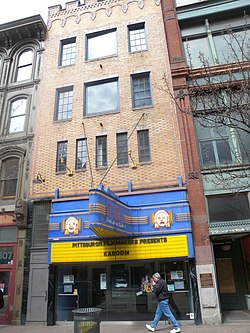Avenue Cinema, Art Cinema | |
 | |
 Interactive map of Harris Theater | |
| Address | 809 Liberty Avenue Pittsburgh, Pennsylvania United States |
|---|---|
| Operator | Pittsburgh Cultural Trust |
| Type | Cinema |
| Capacity | 200 |
| Screens | 1 |
| Construction | |
| Opened | September 14, 1931 |
| Reopened | November 9, 1995 |
| Tenants | |
| Pittsburgh Cultural Trust | |
| Website | |
| trustarts.org | |
The Harris Theater is a landmark building which is located at 809 Liberty Avenue in Downtown Pittsburgh, Pennsylvania's Cultural District. The 200-seat theater is owned and operated by the Pittsburgh Cultural Trust.